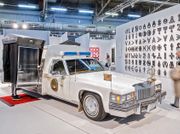Alex Hubbard is a New York based artist who works in painting and video. The use of the two media – in itself an unusual combination - is, for him, inextricably linked. Hubbard’s videos take the question of how the mark ing abstract painting might act as an index of a performative moment and turn it on its head, using the process and practice of painting as an allegory of the everyday. Where their relationship to painting is the most apparent, these films record the manipulation of objects on a flat plane, which, close cropped and shot from above, then becomes the vehicle for paint. At other times they are placed onto what appears to be a painted surface, into which they sink and disappear, revealing the ground as simply liquid paint. In other works again the frame is deeper and the assemblage more sculptural.
Read MoreIn counterpoint to the videos, Hubbard’s paintings often suggest a mechanical means of production. Fields of colour in fibreglass and resin are interrupted with richly pooled, dripped and poured paint. Their surfaces may be stencilled, trowelled or silkscreened – the anti-hierarchical choice of technique parallels the diy aesthetic of the video works. And through this deconstruction every traditional opposition of the formal language of painting is opened up: figure and ground, material and illusionistic depth, the horizontality of production and the verticality of display.




